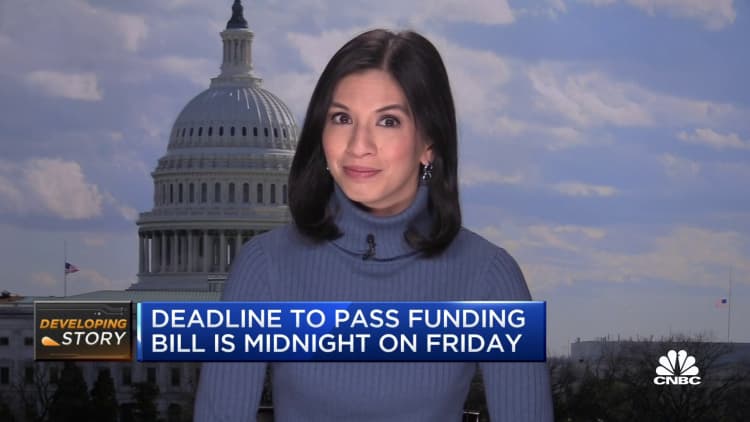Congress’ lame duck session leaves ‘unfinished business’ on issues that address Americans’ everyday financial needs

Parents and children participate in a demonstration organized by the ParentsTogether Foundation in support of the child tax credit portion of the Build Back Better bill outside of the U.S. Capitol on Dec. 13, 2021.
Sarah Silbiger | Bloomberg | Getty Images
Washington lawmakers are rushing to get as much done as possible before the calendar year and the lame-duck session of Congress runs out.
Some changes poised to go through could have a big impact on Americans’ finances, namely some big retirement savings updates poised to get included in a year-end spending bill.
But some other proposed initiatives have not made the cut, and that may also have a big impact on individuals’ and families’ finances until Congress has the chance to revisit them again.
More from Personal Finance:
Secure 2.0 bill on track to usher in retirement system improvements
New retirement legislation leaves a ‘huge problem untouched’
New emergency savings rules may help boost financial security
“Policy advances that would address the everyday needs of low-income people and families were largely left out, despite efforts by many policymakers,” Sharon Parrott, president of the Center on Budget and Policy Priorities, recently wrote of the year-end omnibus package that would keep the government funded through much of 2023.
The “unfinished business” leaves a to-do list for lawmakers on both sides of the aisle next year, she said.
Here’s how the issues that missed the cut this year may crop up again in 2023.
Child tax credit enhancement
A year ago last December, millions of families received their last monthly child tax credit checks.
Legislation to help parents cope with the effects of the Covid-19 pandemic made the child tax credit more generous for the 2021 calendar year. For the first time, that also included advance monthly payments.
The maximum child tax credit sums went up from $2,000 per child to $3,600 per child under age 6 and $3,000 per child ages 6 through 17. Up to half of the more generous sums was sent out in monthly payments to families — $300 per child under 6 and $250 per child ages 6 through 17.
Importantly, it also made the credit fully available to families with little to no income, which helped reduce child poverty.
Now, a big push to renew more generous terms for that tax credit have fallen flat in year-end negotiations.
A key reason why is lawmakers had hoped to attach the effort to corporate tax breaks, which did not end up being considered.
“That’s definitely the biggest, most unfortunate exclusion for the year, no question about it,” Chuck Marr, vice president of federal tax policy at the Center on Budget and Policy Priorities, said of the child tax credit.

The 2021 child tax credit expansion was very successful in driving down child poverty to a record low and helping families meet record costs, Marr noted.
“I think there was a compromise there to be had, and it didn’t happen,” Marr said.
On the bright side, the same compromise to re-up the child tax credit alongside corporate tax breaks may come up again in 2023, he said.
Some lawmakers have insisted the child tax credit gets included in any new tax legislation. “It’s pretty simple — no corporate tax cuts without tax cuts for working families,” Sen. Sherrod Brown, D-Ohio, recently said.
Yet other leaders want to see more rules attached to the child tax credit, such as work requirements, which will likely require compromise, and could mean any new policy may be less generous than the 2021 expansion.
“I think those conversations are going to be starting early next year and continuing throughout the year,” said Shai Akabas, director of economic policy at the Bipartisan Policy Center.
Supplemental Security Income updates
Supplemental Security Income, a federal program that provides benefits to the elderly, blind and disabled, turned 50 this year.
Yet many of the program’s rules have not been updated for decades.
A bipartisan bill from two senators from Ohio — Brown and Republican Rob Portman — would raise the asset limits for beneficiaries to $10,000 for individuals and $20,000 for couples, while also indexing them for inflation.
That proposal did not make the cut in year-end legislation despite high hopes from advocates.
We continue to see a lack of sufficient political will to allow people with disabilities to save.
Rebecca Vallas
senior fellow at The Century Foundation
Today, the program’s asset limits are $3,000 per couple and $2,000 for individuals. That not only limits the amount of savings beneficiaries may have, but it also imposes a marriage penalty on beneficiaries.
“SSI’s punitive and archaic asset limit is the most egregious anti-savings measure in federal law today,” said Rebecca Vallas, senior fellow at The Century Foundation and co-director of the think tank’s Disability Economic Justice Collaborative.
“Yet we continue to see a lack of sufficient political will to allow people with disabilities to save,” Vallas said.
The fate of the proposal is unclear since Portman is retiring this year and it remains to be seen whether another Republican leader will step up to support it, Akabas said.
“It’s going to probably be some time before that gets another opportunity,” Akabas said.
Social Security program funding
The year-end budget deal provides additional funding for the Social Security Administration, but “barely enough to tread water,” Kathleen Romig, director of Social Security and disability policy at the Center on Budget and Policy Priorities, recently wrote.
The deal includes a 6% increase, or $785 million, over the agency’s 2022 funding level, Romig said. President Joe Biden had requested an 11% increase, or $1.4 billion more, she noted. House and Senate committees had also backed more funding for the agency.
The additional funding could have helped the Social Security Administration reduce its backlog and long waits for service by updating its technology systems and hire new staff, Romig noted.
“Instead, applicants and beneficiaries face another year of unacceptable waits for the Social Security and other benefits they’ve earned,” Romig wrote.
Congress likely will not revisit funding for the Social Security Administration until next fall, according to Akabas.
More expansions for emergency savings
New retirement proposals poised to move now include a boost for emergency savings. Plan providers will be able to automatically enroll employees in separate accounts where they can set aside up to $2,500 for near-term needs alongside their retirement funds. Another provision would lets plan participants withdraw $1,000 per year for emergencies without penalty, though some restrictions would apply.
But a proposal that would take that further and allow for separate standalone emergency funds outside of retirement accounts did not make it into the legislation.
That would help nearly 50 million workers who do not have workplace retirement plans to set aside emergency funds, according to Akabas.
The proposal likely did not make it into the year-end legislation likely because it is still being crafted, he said.
“I am cautiously optimistic that in the next year or two that that could pass on some other legislation,” Akabas said.
[ad_2]
Share this news on your Fb,Twitter and Whatsapp
Times News Network:Latest News Headlines
Times News Network||Health||

